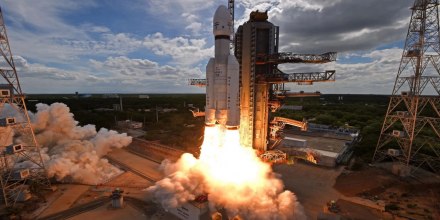Chandrayaan-3's Safe Voyage: Navigating Space Traffic with Precision
07.10.2023 posted by Admin

India's Chandrayaan-3 lunar mission experienced a slight delay in liftoff, shifting its launch time by four seconds to steer clear of potential collisions with other objects in space. The spacecraft embarked on its journey on July 14, riding a LVM-3 heavy-lift rocket from the Satish Dhawan Space Centre and entering an initial highly-elliptical Earth orbit. This marked the beginning of its circuitous route to the moon, ultimately culminating in a remarkable achievement—India becoming the fourth country to successfully execute a soft landing on the lunar surface.
The decision to adjust the liftoff time was made after a thorough analysis of the orbits of various tracked space objects. Anil Kumar, Chief General Manager of Safe and Sustainable Space Operations Management at the Indian Space Research Organisation (ISRO), shared this update at the 74th International Astronautical Congress in Baku on October 6. He emphasized that this practice of adjusting liftoff times for collision avoidance is not exclusive to ISRO but is standard procedure for all space launch missions. It ensures that liftoffs are carried out without any collision threats.
The number of space objects orbiting Earth, particularly in the low Earth orbit, is substantial. The U.S. Space Force monitors and catalogs over 30,000 objects measuring more than 10 centimeters in size. For the specific LVM-3 launch day, a careful analysis revealed that several objects, including operational ones, were on trajectories that brought them within one kilometer of Chandrayaan-3 during its initial orbital phase. To avert potential close encounters, the launch time was adjusted by four seconds.
Following the time adjustment, Chandrayaan-3 was successfully placed into an orbit resembling a geostationary transfer orbit. The spacecraft's orbit was raised multiple times before executing a translunar injection burn. Subsequently, it was captured into an elliptical lunar orbit and then adjusted further to align itself for a landing attempt on August 23.
During a late-breaking news event at the IAC, the initial scientific findings from Chandrayaan-3's Vikram lander and Pragyan rover were discussed. These findings included groundbreaking measurements of the lunar plasma environment near the lunar south pole, providing insights into plasma density, which was found to be relatively low with tens to hundreds of electrons per cubic centimeter. Detailed analysis of these findings is ongoing, with potential implications for lunar radio communication frequencies.
A noteworthy event during the mission was a propulsive "hop" carried out by Vikram on September 2. This hop allowed ISRO to gather additional scientific data from a new location, approximately 40 centimeters from the original landing point. The data collected included fresh temperature measurements from the Chandra's Surface Thermophysical Experiment (ChaSTE) thermal conductivity and temperature payload. This maneuver mirrored the hop performed by the U.S. Surveyor 6 mission in 1967 and served to further validate the accuracy and performance of the scientific instruments on board.
Despite efforts to reestablish contact with the solar-powered Vikram and Pragyan following the lunar night's extreme cold, ISRO's attempts in late September were unsuccessful, leaving the status of these two components uncertain.
The decision to adjust the liftoff time was made after a thorough analysis of the orbits of various tracked space objects. Anil Kumar, Chief General Manager of Safe and Sustainable Space Operations Management at the Indian Space Research Organisation (ISRO), shared this update at the 74th International Astronautical Congress in Baku on October 6. He emphasized that this practice of adjusting liftoff times for collision avoidance is not exclusive to ISRO but is standard procedure for all space launch missions. It ensures that liftoffs are carried out without any collision threats.
The number of space objects orbiting Earth, particularly in the low Earth orbit, is substantial. The U.S. Space Force monitors and catalogs over 30,000 objects measuring more than 10 centimeters in size. For the specific LVM-3 launch day, a careful analysis revealed that several objects, including operational ones, were on trajectories that brought them within one kilometer of Chandrayaan-3 during its initial orbital phase. To avert potential close encounters, the launch time was adjusted by four seconds.
Following the time adjustment, Chandrayaan-3 was successfully placed into an orbit resembling a geostationary transfer orbit. The spacecraft's orbit was raised multiple times before executing a translunar injection burn. Subsequently, it was captured into an elliptical lunar orbit and then adjusted further to align itself for a landing attempt on August 23.
During a late-breaking news event at the IAC, the initial scientific findings from Chandrayaan-3's Vikram lander and Pragyan rover were discussed. These findings included groundbreaking measurements of the lunar plasma environment near the lunar south pole, providing insights into plasma density, which was found to be relatively low with tens to hundreds of electrons per cubic centimeter. Detailed analysis of these findings is ongoing, with potential implications for lunar radio communication frequencies.
A noteworthy event during the mission was a propulsive "hop" carried out by Vikram on September 2. This hop allowed ISRO to gather additional scientific data from a new location, approximately 40 centimeters from the original landing point. The data collected included fresh temperature measurements from the Chandra's Surface Thermophysical Experiment (ChaSTE) thermal conductivity and temperature payload. This maneuver mirrored the hop performed by the U.S. Surveyor 6 mission in 1967 and served to further validate the accuracy and performance of the scientific instruments on board.
Despite efforts to reestablish contact with the solar-powered Vikram and Pragyan following the lunar night's extreme cold, ISRO's attempts in late September were unsuccessful, leaving the status of these two components uncertain.